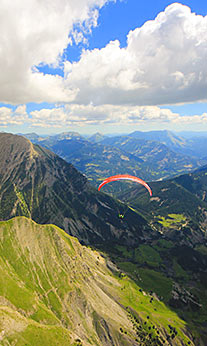
This week's tip is from Fifty Ways to Fly Better, the new book by Bruce Goldsmith and friends.

"Wind likes to gather in gullies while thermals prefer to run up spines."
Low down, gullies that face the wind are good places to find lift – they act like collection points for the wind and thermals that are channelled into them.
Once dragged in and climbing up a gully, a thermal will try to take the most direct and vertical route possible to cloudbase that still keeps it in touch with the terrain. So unless the gully is very steep, the thermal will soon climb out of the back of the gully and try to take a more direct route to the sky.
Often a thermal will roll up the side walls of a gully until it finds a spine to follow. Spines offer thermals an easy route to the sky, and once rolling up one, there is often no other possible route to take. The thermal will then stick to the feature until it either reaches a peak, or the feature sharply decreases in angle, causing the thermal to break free.
However, if you are flying in a crosswind from either a valley flow or meteo wind, the thermal’s route might well take it diagonally across the face until it reaches a ‘breakaway’ point. This is where the terrain turns, and causes the thermal to let go. Any sudden change in angle of the terrain along the thermal’s route is a potential breakaway point.
When you’re trying to predict a route, you should study the terrain very carefully for breakaway points. They can be hard to spot, and to the untrained eye the best breakaway point can sometimes look like the worst place in the world to go, as they are quite often not dynamically soarable.


Join the family now by subscribing at
www.xcmag.com or call +44 (0) 1273 256 090
If you don't normally receive this newsletter sign up here
to have it delivered directly to your mailbox
Forward this to a friend ![]() share on Facebook
share on Facebook ![]() share on Twitter
share on Twitter